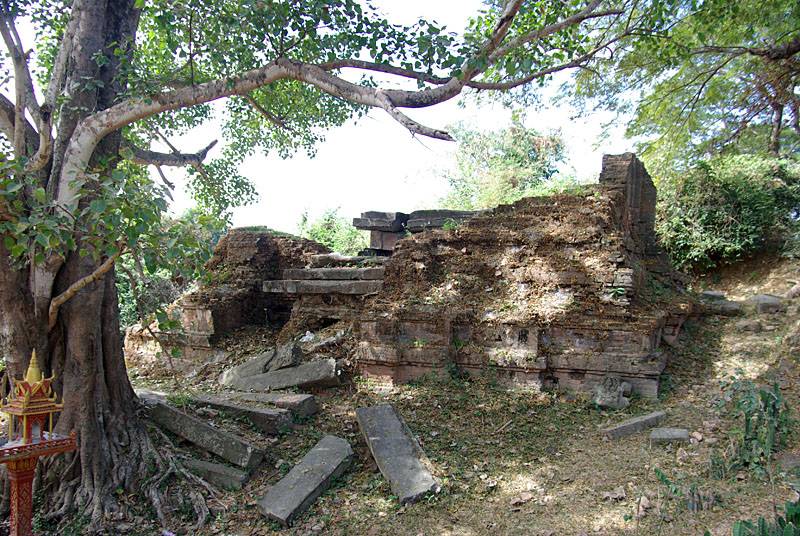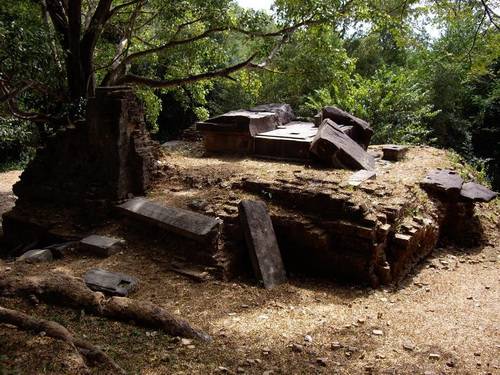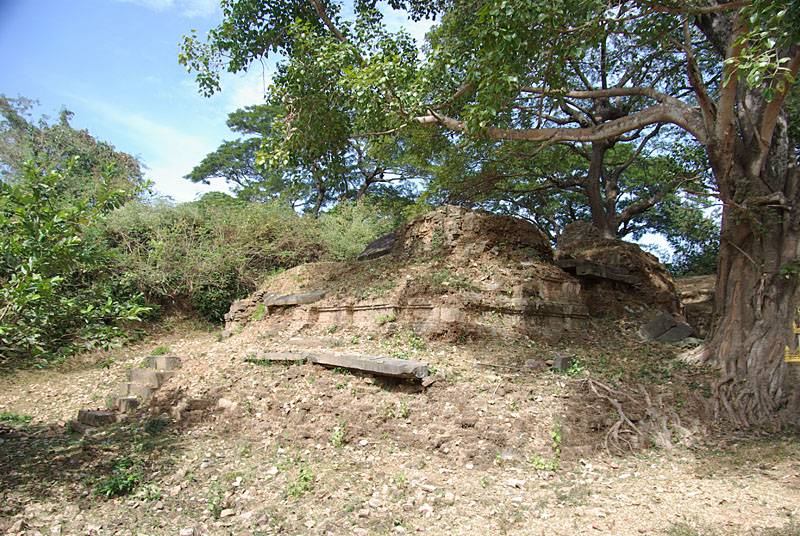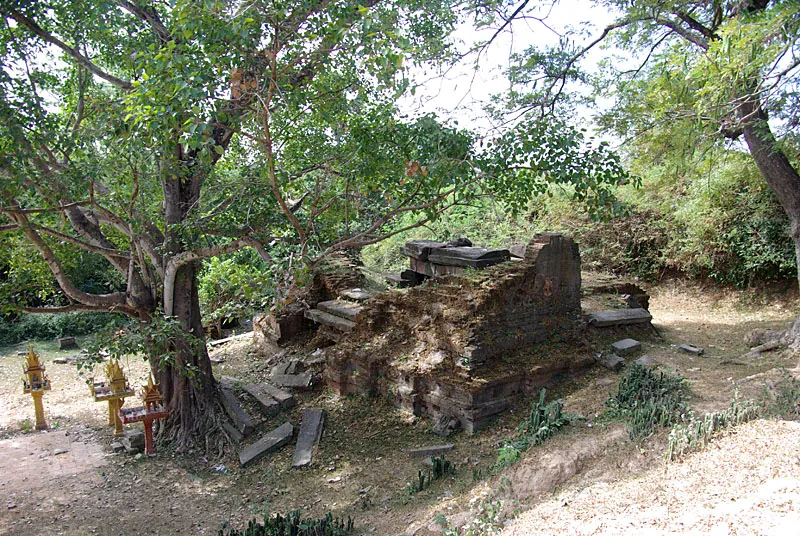Ak Yum is an ancient temple located in the Angkor region of Cambodia. It predates the famous Angkor Wat and is one of the earliest examples of temple mountain architecture in the area. The temple was initially a single-level structure, which later underwent significant expansion to become a stepped pyramid. This transformation reflects the evolving architectural styles and religious practices of the time. Ak Yum is a testament to the ingenuity of the Khmer civilization and offers valuable insights into the early development of temple construction in Southeast Asia.
Get your dose of History via Email
Historical Background of Ak Yum
Archaeologists discovered Ak Yum in the 20th century, but the exact date and individual remain unclear. The temple was built in the 8th century, during the pre-Angkorian period. It is one of the earliest known examples of the stepped pyramid design that would later characterize Khmer architecture. King Jayavarman II, considered the founder of the Khmer Empire, is often associated with its construction. Over the centuries, Ak Yum saw additional structures and modifications, indicating its continued importance. The temple also witnessed significant historical events, including the rise of the Khmer Empire.

Located at the southern edge of the West Baray, a massive reservoir, Ak Yum played a crucial role in the region’s water management system. This strategic position suggests that it may have had a dual purpose, both religious and practical. The temple’s proximity to water is a common feature in Khmer architecture, symbolizing the cosmic ocean. Later, the site became less central as the focus of power shifted towards Angkor Wat and other monumental temple complexes.
Despite its significance, Ak Yum did not maintain prominence throughout the Khmer Empire’s history. As new leaders ascended, they often built their own state temples, leaving older ones like Ak Yum to fade into the background. However, the temple’s influence on later structures is undeniable. It set a precedent for the grandeur and complexity of Khmer religious sites. The temple’s decline did not erase its historical importance, and today, it is recognized as a critical piece of Cambodia’s cultural heritage.
Excavations and studies at Ak Yum have provided valuable information about the early Khmer civilization. The site has yielded artifacts and structural evidence that help historians piece together the region’s history. Ak Yum’s construction techniques and design elements are particularly informative, as they show the transition from pre-Angkorian to Angkorian architecture. The temple’s history is not just about the structure itself but also about the people who built it and the society they lived in.
Today, Ak Yum stands as a historical site within the Angkor Archaeological Park. It attracts scholars and tourists alike, who come to marvel at its ancient design and ponder its past. The temple may not be as grand or as well-preserved as some of its successors, but it holds a unique place in the story of the Khmer Empire. Its ruins serve as a humble reminder of the empire’s origins and the enduring legacy of its builders.

About Ak Yum
Ak Yum’s initial structure was a simple shrine that later evolved into a more complex stepped pyramid. The temple was constructed using laterite and sandstone, materials commonly used in Khmer architecture. The laterite provided a sturdy base, while the sandstone was used for more intricate carvings and details. The temple’s design includes a central tower, which was a typical feature of Khmer religious architecture, symbolizing the sacred mountain, Mount Meru.
The temple’s expansion involved adding four successive tiers, creating a stepped pyramid that increased the monument’s height and grandeur. Each tier was smaller than the one below, giving the structure its distinctive pyramid shape. The expansion of Ak Yum was not just physical but also symbolic, as it reflected the growing power and ambition of the Khmer rulers.
Architectural highlights of Ak Yum include the intricate carvings and bas-reliefs that adorn its walls. These carvings depict Hindu deities and mythological scenes, indicating the temple’s religious significance. The presence of these carvings also provides insights into the religious beliefs and artistic practices of the Khmer people during the pre-Angkorian period.
Over time, the temple has suffered from the ravages of nature and time. The tropical climate and encroaching vegetation have taken their toll on the ancient structure. Conservation efforts are ongoing to preserve what remains of the temple. These efforts ensure that Ak Yum can continue to be a source of knowledge and inspiration for future generations.
The construction techniques used at Ak Yum laid the groundwork for the architectural marvels that would follow in the Angkor region. The temple’s design and building materials influenced the construction of later temples, including the iconic Angkor Wat. Ak Yum’s legacy is not only in its physical remains but also in the architectural traditions it helped to establish.

Theories and Interpretations
Several theories exist about Ak Yum’s original purpose and significance. Some scholars suggest it was a religious site dedicated to Hindu deities, as evidenced by the carvings found on its walls. Others propose that it may have served as a funerary temple or a site for royal ceremonies. The true purpose of Ak Yum remains a topic of debate among historians and archaeologists.
The mysteries surrounding Ak Yum extend to its architectural evolution. The reasons behind its transformation from a single-level structure to a stepped pyramid are not entirely clear. Some believe this change reflects a shift in religious practices or an increase in the ruler’s power. Others see it as a response to practical needs, such as water management or territorial expansion.
Interpretations of Ak Yum’s carvings and inscriptions have provided valuable insights into the religious and social life of the Khmer people. These artistic elements are matched to historical records to gain a better understanding of the period. However, gaps in the historical record leave room for speculation and further research.
Dating Ak Yum has been a complex process. Archaeologists have used a combination of stylistic analysis and radiocarbon dating to estimate the temple’s age. These methods have helped to place Ak Yum within the broader timeline of Southeast Asian history, although some uncertainty remains about the exact dates of its construction and expansion.
The ongoing study of Ak Yum continues to yield new theories and interpretations. As more evidence is uncovered, our understanding of the temple’s role in Khmer history becomes more nuanced. Ak Yum is a puzzle that scholars are still piecing together, and each discovery adds another piece to the complex picture of Cambodia’s past.
At a glance
Country: Cambodia
Civilization: Khmer Empire
Age: 8th century AD

